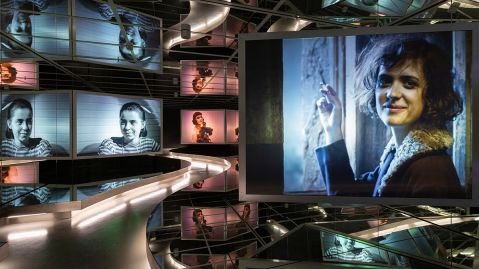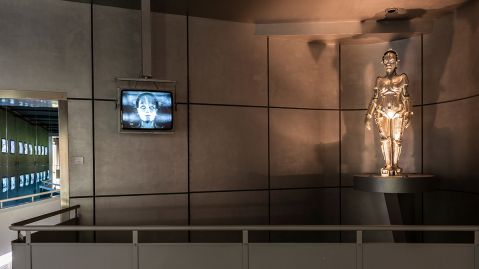
Our permanent exhibition is closing
General information
-
Your visit
Find out moreAddress, opening hours, FAQ.
-
Information about our relocation
Find out moreFrom 2025, we will be housed in E-Werk.
-
Free audio guide
App Store Google Play StoreExplore more than 120 years of film history with our free audio guide.
Film as art, film as commodity, film as spectacle and a seismograph of social developments – cinema and television have radically changed the way we see the world and ourselves in the 20th century. Until 31 October, we invite you to dive into the world of moving images – with free admission from 24 to 31 October!
Our permanent exhibition traces the rapid development of film – from the first silent movies to today’s audience favorites, experiments in early analog TV, and the digital formats of the present day. In addition to German film history, we have some international highlights, especially when it comes to Hollywood. Film-makers and actors forced into exile by the National Socialists are honored with their very own room. Elsewhere, the exhibition of German television shows the medium’s development from initial experiments with the direct transmission of electronic images to modern programming.
The permanent exhibition forges links between media history and culture, society and politics. From Imperial Germany to the Weimar Republic, National Socialism and the post-war developments in East and West Germany, all the way to reunification, we always keep our sights on the ruptures throughout German history.
You can also look forward to an extensive tour program (in German, see German website) featuring retrospectives and exciting thematic focuses set by our curators and speakers.
One more time:
Main themes
Pioneers and Divas (1895–1918)
In its early days, cinema was an attraction akin to a variety show or a fun fair. The first films to be shown on a big screen – anywhere in the world – were presented by the Skladanowsky brothers in the Wintergarten variety theatre in Berlin. It was only gradually that cinema managed to free itself from its reputation as cheap entertainment and convince a middle-class audience of its artistic potential. Newspaper feature pages were full of discussions about this unprecedented, novel medium, which was starting to compete with literature and the theatre. The construction of grand cinemas, the improvement of recording and projection technologies and the development of a specific film language contributed to cinema, in spite of its initial poor image as entertainment for the masses, eventually developing into a great success.
1912 saw the completion of the Glasatelier in Babelsberg – the first studio building and original incarnation of the modern European studio complex. Just as such studios had done earlier in the USA, this one created celebrated stars in Germany too, including the globally revered Danish actress Asta Nielsen, who worked in Germany, and German talents such as Henny Porten or the now almost entirely forgotten Fern Andra.
‘Das Cabinet des Dr. Caligari’ (1920)
After the First World War, Germany was searching for new paths beyond militarism and authority and was attempting to establish a parliamentary democracy. Nevertheless, dark memories of the War were still on people’s minds. It was in this atmosphere that ‘The Cabinet of Dr Caligari’ (D 1920, director: Robert Wiene) was produced. The film captivates its audiences through its unique visual style, and portrays an uncanny world full of hypnotised figures and hallucinations. As the epitome of German expressionist cinema, it set a benchmark for horror as a genre.
The film historian Lotte Eisner praised this work in her famous book ‘The Haunted Screen’. “The cinematic image must become an artwork,” said one of the architects of the film. Its exquisitely designed sets and shadow effects enhance the dark terror of the storyline.
Weimar Republic (1918–33)
In the years between the World Wars, cinema-going audiences became more diverse – as did the range of films on offer. Aside from melodramas, comedies, thrillers and the first erotic films, there were national myths, ambitious literary adaptations, avant-garde experiments and socially-engaged films.
The most influential directors from this period included Ernst Lubitsch, F. W. Murnau, Fritz Lang and G. W. Pabst. Stars such as Pola Negri, Brigitte Helm, Emil Jannings and Marlene Dietrich conquered the silver screen. Daily life and legend, triviality and technology defined the cinema of the Weimar Republic, which also portrayed harbingers of the dictatorship to come.
‘Metropolis’ (1927)
Ranges of skyscrapers, seas of buildings, machine halls, catacombs, the Tower of Babel, a cathedral and paradisiacal gardens: in Fritz Lang’s ‘Metropolis’ (D 1927), architecture becomes a symbol of domination and hierarchy, of freedom and oppression, of power and powerlessness. The film combines early science fiction with striking set design.
The young Maria, a redeemer figure, encounters her mechanical doppelgänger, a human-machine. The eternal struggle between good and evil unfolds – and good prevails. “The intermediary between the brain and the hand must be the heart,” reads Thea von Harbou’s screenplay. ‘Metropolis’ combines social reality with visionary ideas, a utopia with an apocalypse.
Transatlantic (1918–33)
In the 1920s, Berlin became the cinematic capital of Europe. Even then, though, the global centre of filmmaking was already Hollywood. Artists from Germany and Austria such as Ernst Lubitsch, F. W. Murnau and Emil Jannings were thus drawn to California as early as the days of silent film. Thanks to these talents and their experience, Hollywood incorporated the best of certain European cinematographies and in so doing entrenched the leading role played by American cinema.
From 1928, the talkies prevailed in the USA. German-speaking actors, and to a lesser degree directors, had difficulties working in English. Many only stayed in the USA for a short period, and only a few succeeded in establishing themselves there permanently. After the Nazis took power in 1933, they formed the centre of German emigration in Hollywood.
Marlene Dietrich (1901–1992)
No other figure in German cinema has had such as impressive acting career as Marlene Dietrich. Her global success began in 1930, almost simultaneously in Berlin and in Hollywood. She shot six films in Hollywood with the director Josef von Sternberg: ‘Morocco’ (1930) and ‘Shanghai Express’ (1932) were their most successful collaborations.
Until 1939, Marlene Dietrich would frequently spend long periods of time in Europe. However, she refused an offer from the German propaganda minister, Goebbels, for her to return to Germany. During the years 1944 and 1945, Marlene Dietrich actively supported the struggle against National Socialism, which earned her enduring resentment in her old homeland even after the end of the War. She performed for American soldiers in Africa and Europe in order to boost morale among the troops. In 1948, under Billy Wilder’s direction, she played the role of a German bar singer in the satirical comedy ‘A Foreign Affair’. The film is set in post-war Berlin.
Marlene Dietrich provoked people with her roles, her songs and the clothes she wore. Her appearances in men’s clothes – both on film and in society – were skilfully staged transgressions, which made of her an icon of the 20th century.
‘Olympia’ (1936–38)
In 1936, the summer Olympics took place in Berlin. The Nazi regime used this event to present itself as cosmopolitan and tolerant. The Hitler admirer Leni Riefenstahl was commissioned to document the competition on camera. The imagery of her two-part film ‘Olympia’ mainly takes its dynamism from the stylistic methods of modern photography and montage that had been developed in the 1920s. The internationally award-winning film celebrates the athletic body and was viewed as a masterpiece of the staged documentary film – but it was also a propaganda film.
Two years earlier, Leni Riefenstahl had already portrayed the Nazi Party’s Nuremberg Rally in ‘Triumph of the Will’, and in so doing also used new techniques and unusual camera angles. After the war, she claimed – as did many of her compatriots – that “she didn’t know anything”, and took legal action against her critics.
National Socialism (1933–45)
After the Nazis took power in 1933, the German film industry readily adapted itself to the National Socialist regime. Jewish employees were fired, and film production was entirely tailored to the views of the new ruler, in order to serve a general public which was offered both entertainment that complied with Nazi guidelines and requirements, and propaganda films which disseminated racial fanaticism and fantasies of domination.
Aside from antisemitic films and films which promoted military strength, the feature film industry in the ‘Third Reich’ mainly produced comedies and review films. These were intended – especially after the start of the Second World War in 1939 through the invasion of Poland – to help audiences escape from their daily lives for a short while.
Exile (1933–45)
The Latin word “exsilium” means both banishment and salvation. For many people, fleeing Nazi Germany was their hope of survival. Jewish Germans, political activists and artists sought refuge, often overseas, and particularly in the USA.
After Hitler took power, Hollywood became a place of salvation for around 2,000 film artists. Prominent names such as Fritz Lang, Ernst Lubitsch, Max Ophüls, Marlene Dietrich and Peter Lorre fled to the USA. Many were not able to continue their careers, or only found work with difficulty. Salvation also meant losing your home, your culture and your identity. Often people held on to the hope that they might one day return to a freed Germany.
From the Post-War Period... (1946–80)
The first four decades following the end of the Second World War were defined by the division of Germany into two countries. In the GDR, the DEFA’s film production was subject to strict government control. Conflicts with the censors were frequent. In 1965, almost the entire annual film production was banned, in particular films with contemporary themes, among others by Frank Beyer and Kurt Maetzig.
In the mid-1960s, the Federal Republic of Germany saw the emergence of a new generation of directors who pushed against the dominance of films as entertainment, including Rainer Werner Fassbinder, Werner Herzog, Alexander Kluge, Jeanine Meerapfel, Helke Sander, Margarethe von Trotta and Wim Wenders. Their works, which became famous under the name of “New German Cinema” gained international recognition.
In the 1970s, filmmakers in both countries continued to engage intensively with the world around them. Their works offer up a variegated panorama of German post-War film history.
...to the Present-Day (1981 to today)
At the beginning of the 1980s, many German film directors started to work abroad in Europe and in the USA. In East German cinema, the first signs of the political change that would come to completion in 1989 started to become visible.
After the Fall of the Berlin Wall, the next generation of filmmakers intensively confronted German history. Their films about the Nazi dictatorship, the terrorism of the Baader-Meinhof Gang and the Fall of the Berlin Wall became huge hits both in Germany and abroad. The images of Germany presented in these films are often very personal.
Today, international co-productions shape filmmaking in Germany, and television plays a major role as a co-producer. Series such as ‘Babylon Berlin’ or ‘Dark’ and current films such as ‘All Quiet on the Western Front’ or ‘Berlin Alexanderplatz’ have been major international hits.




